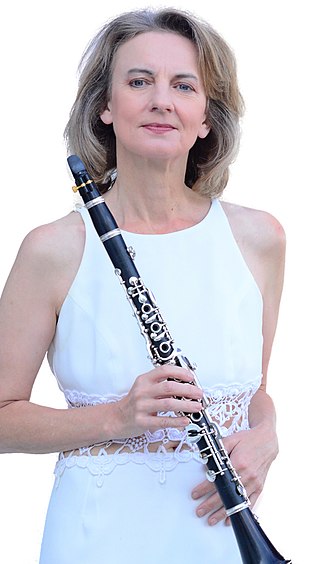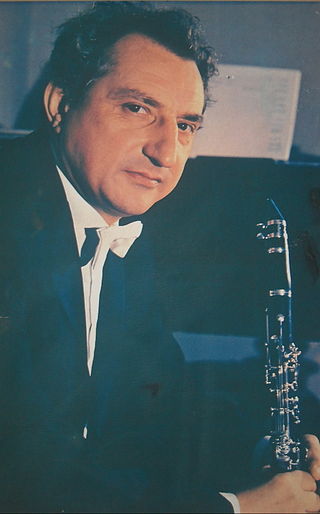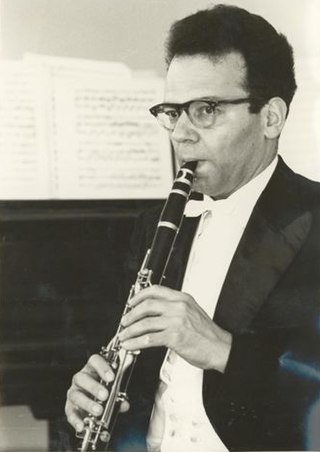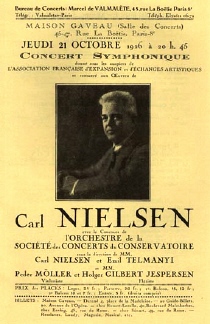
Carl August Nielsen was a Danish composer, conductor and violinist, widely recognized as his country's most prominent composer.

Per Nørgård is a Danish composer and music theorist. Though his style has varied considerably throughout his career, his music has often included repeatedly evolving melodies—such as the infinity series—in the vein of Jean Sibelius, and a perspicuous focus on lyricism. Reflecting on this, the composer Julian Anderson described his style as "one of the most personal in contemporary music". Nørgård has received several awards, including the 2016 Ernst von Siemens Music Prize.

Symphony No. 5, Op. 50, FS 97 is a symphony composed by Carl Nielsen in Denmark between 1920 and 1922. It was first performed in Copenhagen on 24 January 1922 with the composer conducting. It is one of two of Nielsen's six symphonies lacking a subtitle, the other being his Symphony No. 1.

David Shifrin is an American classical clarinetist and artistic director.

Sabine Meyer is a German classical clarinetist.
Louis Cahuzac was a French clarinetist and composer. Cahuzac was an outstanding performer and one of the few clarinetists who made a career as a soloist in the first part of the 20th century.

Milenko Stefanović was a Serbian classical and jazz clarinetist. He was a prizewinner in the international competitions in Moscow, Munich, Geneva and Prague, and achieved an international career as a soloist. He was a long-time principal clarinetist of the Belgrade Philharmonic Orchestra and Professor of Clarinet at the University of Priština and University of the Arts in Belgrade.
Aaron Copland's Clarinet Concerto was written between 1947 and 1949, although a first version was available in 1948. The concerto was later choreographed by Jerome Robbins for the ballet Pied Piper (1951).
Stanley Drucker was an American clarinetist. For nearly five decades, he was principal clarinetist of the New York Philharmonic. According to Guinness World Records, he achieved the longest career as a clarinetist. Drucker premiered the clarinet concerto by John Corigliano.
Walter, Knight Boeykens was a Belgian conductor and a world-renowned clarinetist. Boeykens' impressive discography, including several critically acclaimed performances, are testimony to his status as one of the most notable clarinetists of the 20th century. Boeykens remained active and was in concert frequently all around the world until his death in 2013.
Karl Aage Rasmussen is a Danish composer and writer.

Sebastian Manz is a German clarinetist. He is solo clarinetist in the SWR Symphonieorchester, international soloist and chamber musician. He is also active as an arranger and composer.
Wolfgang Meyer was a German clarinetist and professor of clarinet at the Musikhochschule Karlsruhe. He worked internationally as a soloist, in chamber music ensembles, and in jazz, with a repertoire from early music played on historical instruments to world premieres.
Fredrik Fors is a Swedish, classical music clarinetist. His album in the Juventus Les Nouveaux Musiciens series has been described as "one of the finest recitals of its kind".

Yona Ettlinger was a clarinetist who played and taught in Israel, France and England. Ettlinger is considered a prominent classical clarinetist of his generation, and one of Israel's notable instrumentalists. His musicianship and unique sound influenced the art of clarinet playing in Israel and Europe in the second half of the 20th century. Many clarinet soloists and orchestra players of different countries were among his students.

Carl Nielsen's Concerto for Flute and Orchestra was written in 1926 for Holger Gilbert-Jespersen, who succeeded Paul Hagemann as flautist of the Copenhagen Wind Quintet. The concerto, in two movements, was generally well received at its premiere in Paris in October 1926 where Nielsen had introduced a temporary ending. The first complete version was played in Copenhagen the following January. The flute concerto has become part of the international repertoire.

Carl Nielsen's Wind Quintet, or as indicated by the original score, the Kvintet for Flöte, Obo, Klarinet, Horn og Fagot, Op. 43, was composed early in 1922 in Gothenburg, Sweden, where it was first performed privately at the home of Herman and Lisa Mannheimer on 30 April 1922. The first public performance was on 9 October 1922 in the smaller hall at the Odd Fellows Mansion in Copenhagen. It is considered a staple of the repertoire for wind quintet.
Aage Oxenvad was a Danish clarinetist who played in the Royal Danish Orchestra from 1909. Carl Nielsen wrote his Clarinet Concerto for Oxenvad who played at its premiere in 1928.

Holger Gilbert-Jespersen was a Danish flutist, orchestral musician and academic flute teacher. In 1926, Carl Nielsen's Flute Concerto was written for, dedicated to, and first performed by Gilbert-Jespersen in Paris. He was a member of the Royal Danish Orchestra from 1927 to 1956 as well as a professor at the Royal Danish Academy of Music from 1927 to 1962, where he trained generations of flutists.

Janet Lesley Hilton is a British clarinet soloist, teacher, chamber performer, and orchestral musician. She has gained widespread recognition for her extensive recordings with the Chandos and Naxos record labels.











